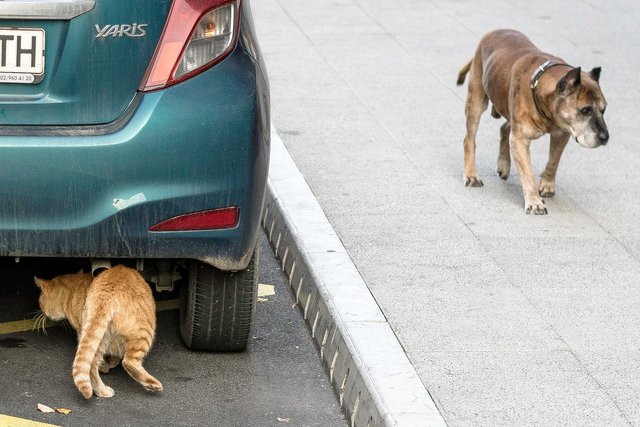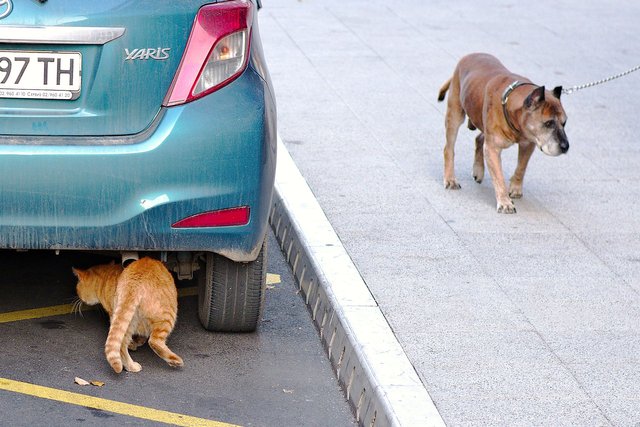DEK Photography: Misuse of Image Manipulation (Bending the Truth). Also, Lightroom vs Corel Aftershot!
What is the acceptable boundary of image manipulation? I had a short discussion with @ocrdu and decided to illustrate my point.
Look at that! A massive, muscular pitbull, with a mean look on his face, hunting for the cat, whose scent he just picked. The cat is in trouble and it's making a quick escape, under the relative safety of the car.
There's tension in this photo, an expectation of the grim fate of this kitty, which happened to be in the wrong place, at the wrong time.

Click for a bigger image! Edited in Adobe Lightroom and Photoshop, under Windows.
Now, here's the original image, this time without any factual manipulation. I shot a guy, walking his dog. It's on a leash. The dog had no idea there was a cat, and was just following along his master. The cat simply tried to evade a possible conflict, but it knew it was perfectly safe.
No tension, no fear, no suspense. A photo, which most people won't even consider all that interesting.

Click for a bigger image! Edited with Corel AfterShot 2, under Linux.
The leash made all the difference in this photo. Was it the moral thing to edit it out? Not really. Photography may be an art, which often involves sharpness, contrast or color manipulation, but bending the truth by retouching or cropping out important factual details, should always be avoided.
Have your say in the comments, I always enjoy discussions on journalistic ethics!
A bit about the software used. I've edited the RAW file in both Lightroom (first photo) and AfterShot (second file). I've decided to separately edit the photos to the best of my judgment and the softwares' functionality. Obviously this resulted in slightly different exposure and and white balance. But I've noticed the following two apparent differences:
- I've added the maximum sharpness to the second photo (AfterShot) and it's still considerably blurrier than the first one (check out the dog's nose).
- There's more detail in the first photo (Lightroom; look at the cat's fur and the asphalt below it). AfterShot exports much "blotchier" .jpg files (no noise reduction was used at all; it's as sharp as it's possible).
Sadly, as much as I love Linux, I still have to double boot to use Lightroom. But Corel's AfterShot 2 is much better than it used to be several months ago, so I hope that we will have a good Linux RAW image processor relatively soon.
Follow more of my photography work on #dek-photography!
Check out my latest articles:
I offer Professional Translation and Editing Services in exchange for Steem.
I now notice something interesting - the Lightroom image has a color profile which renders wrong under mobile, but not desktop browsers. I should look into that and write a follow up!
From what I see in the EXIF metadata, your image uses ProPhoto RGB profile. Not all browsers and operating systems support alternative color profiles, and some websites remove all metadata including the color profile info from images. I'm not familiar with Lightroom, but there should be an option to use sRGB, which is the standard color space that most systems use by default, so it is the safe choice for web publishing.